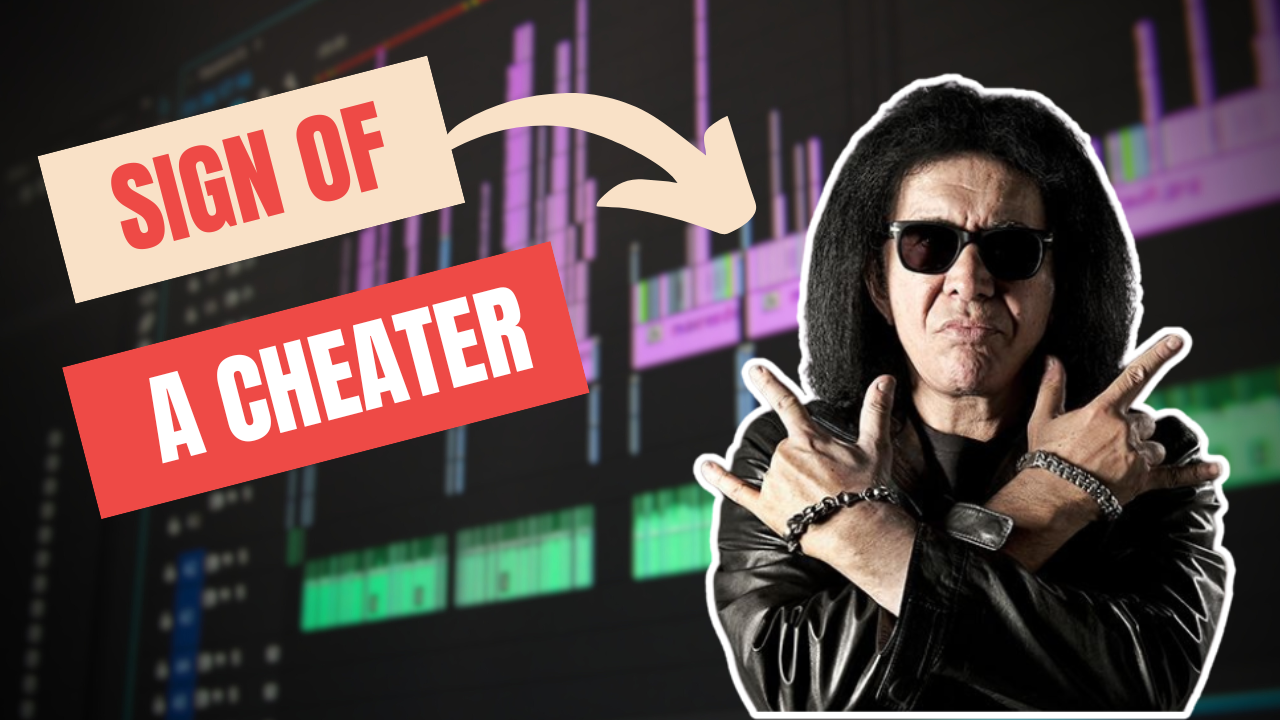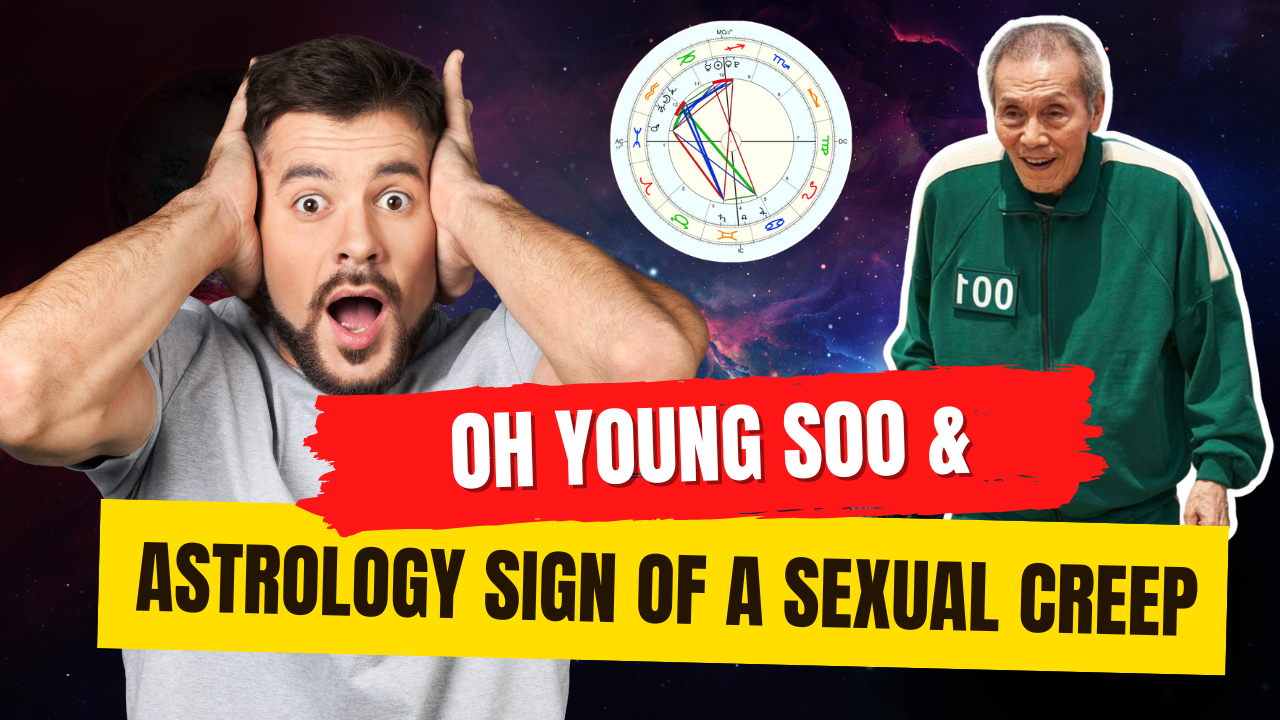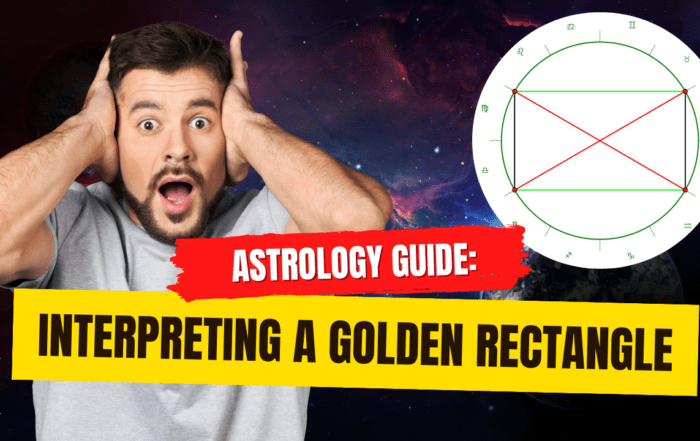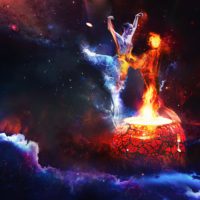Hello everyone, I’m Duy Magi. Today, I’ll teach you a method of how to read a birth chart based on Multiverse Astrology. And this methodology can read a birth chart accurately even without a birth time.
But before we dive into the details, let’s understand the nature of this method. So, let’s explore a bit about the history of Astrology together.
If you don’t want to read such a long article, please watch the video version below:
History of Israel & The Mystical Power of the Star of David Geometry
When we talk about Astrology today, we often think about which zodiac sign a person is born under. And if you dig deeper, you might want to know how your rising sign and the positions of planets in the 12 houses.
However, there was a time in history when astrologers didn’t focus much on that. Instead, they were interested in how planets interacted with each other and formed certain aspects and geometries.
So, let’s turn back to the history of Israel to learn more about this. This is recorded in historical books through the story of choosing a successor in Israel.
Specifically, the first king of Israel made a bold decision by choosing the shepherd boy David, not from a royal lineage, as his heir. The reason for this decision was that David was born on a very special day when 6 out of 7 visible planets in the sky formed a perfect hexagon geometry.
As expected, David later became one of the greatest kings in the history of Israel. Nowadays, this hexagon geometry is named the Star of David and is proudly displayed on the flag of Israel.
From this, we can see that ancient astrologers discovered the mystical power of planetary geometries.
The Biggest Plot Twist & The Birth of the 12 Zodiac Astrology
But for some subjective and objective reasons, some time later, astrologers completely shifted their focus on astrology study and concentrated on analyzing the characteristics of each planet as they entered each Zodiac sign and house.
So, this plot twist pushed the development of astrology into a new phase, establishing a new order in the world of astrology. This laid the foundation for the widely popular 12 Zodiac Astrology System used today.
I will have a separate video delving deeper into this shift. However, in today’s video, you just need to know that ancient astrology was not entirely similar to today’s astrology.
However, focusing on the 12 Zodiac Signs and 12 Houses has reduced the accuracy of astrology.
And this was demonstrated in Shawn Carlson’s 1985 study published in the journal Nature titled “A double-blind test of astrology.”
Specifically, 28 renowned astrologers from the United States and Europe were invited to read birth charts to predict the personalities of over 100 volunteers.
However, the results showed that the 12 Zodiac Astrology System was only accurate about 30%.
Therefore, the shift in the development of astrology from Planetary Geometry to the 12 Zodiac Signs and 12 Houses seems to be a mistake.
Multi Dimensions: The Art of Multiverse Astrology
Aware of this, Multiverse Astrology was created with the goal of bringing astrology back to its primitive nature. And Multiverse Astrology focuses on analyzing Planetary Geometry.
However, the breakthrough of the Multiverse Astrology System is the use of 6 dimensions and hundreds of planets, asteroids, and midpoints. And all celestial symbolisms undergo extensive testing to ensure accuracy.
Therefore, Multiverse Astrology provides very high accuracy.
Focusing on Planetary Geometry has helped Multiverse Astrology operate accurately even when the birth time is unknown.
The reason is that the Solar System has many planets and asteroids that move relatively slowly, maintaining their positions within a day.
Consequently, the geometries they create in a day remain almost unchanged. Analyzing these Planetary Geometries can reveal much about a person’s personality.
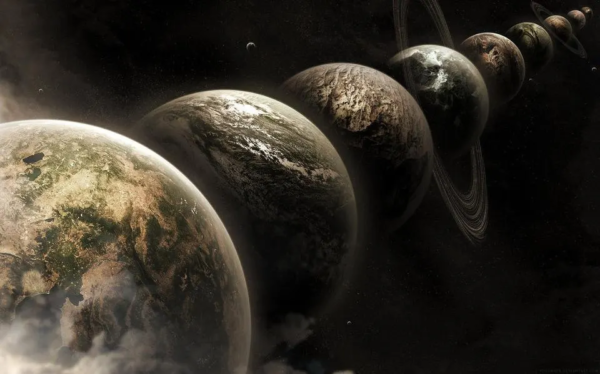
Additionally, there are celestial bodies that move rapidly, such as the Moon, whose position changes significantly throughout the day.
However, the number of fast-moving celestial bodies is much less compared to the slower ones.
Therefore, individuals born on the same day share many personality traits, with slight individual differences. That’s why, even without a birth time, Multiverse Astrology can still operate accurately.
Exploring the 6D Universe of Multiverse Astrology with AstroPro
Previously, practicing Multiverse Astrology was challenging because to read a birth chart in Multiverse Astrology style, astrology students need an expensive specialized astrology software to create the birth chart.
However, everything changed when I and my close friend Sáng Trần created a free tool for drawing Multiverse Astrology birth charts in 6 dimensions called AstroPro, available at https://en.astropro.vn/.
So, before you start practicing, visit AstroPro. I have a tutorial video on how to use AstroPro, and you can watch it below:
Now, let’s explore the 6 dimensions and how to read a birth chart in Multiverse Astrology.
Specifically, there are six charts, consisting of three Geocentric charts and three Heliocentric charts. In the Geocentric charts, with Earth as the center, the Sun will appear. Conversely, in the Heliocentric charts, with the Sun as the center, Earth will appear.
Using Heliocentric charts may seem unfamiliar to many. However, few know that some of the most successful astrologers in human history, such as William Delbert Gann and Benjamin Franklin, used Heliocentric charts in their analysis.
Therefore, if you truly want to become a master in Astrology, you must learn how to read charts in multidimensional space.
Exploring the Geocentric & Heliocentric Longitude Zodiac 12 Dimension
First, let’s familiarize ourselves with the Geocentric Longitude Zodiac 12 & Heliocentric Longitude Zodiac 12 dimensions.
The Longitude Zodiac 12 dimension divides the circle of 360 degrees into 12 parts of 30 degrees and examines the aspect interactions of planets.
Specifically, there will be 7 types of aspects:
-
Conjunct/Conjunction 0 degrees: Colored Green
-
SemiSextile 30 degrees: Colored Black
-
Sextile 60 degrees: Colored Black
-
Square 90 degrees: Colored Red
-
Trine 120 degrees: Colored Green
-
Quincunx 150 degrees: Colored Blue Navy
-
Opposite/Opposition 180 degrees: Colored Red
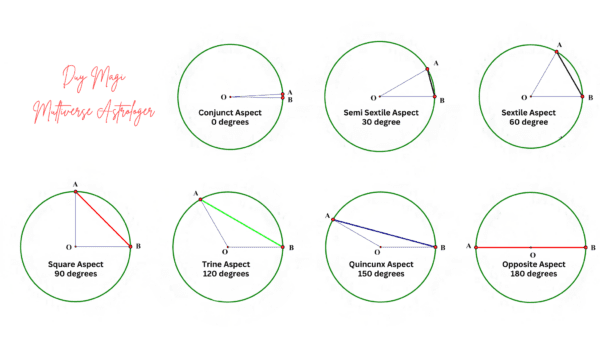
However, the 7 aspects above have very different characteristics, specifically as follows:
-
Positive Aspects: Conjunct & Trine
-
Negative Aspects: Square & Opposition
-
Neutral Aspects: SemiSextile & Sextile
-
Dual Aspect: Quincunx
Specifically, the Quincunx aspect can be positive when both participating planets are positive. On the contrary, if one planet is negative, the Quincunx aspect becomes challenging.
Typical negative planets used in Multiverse Astrology are Saturn, Sappho, Xanthus.
Therefore, it’s crucial to understand this to avoid confusion.
The Aspect Orb for these aspects is 3 degrees for both Geocentric Longitude Zodiac 12 and Heliocentric Longitude Zodiac 12.
However, in some cases, we may extend the Orb to 4 degrees. So, I will have a separate video explaining this issue.
Each aspect mentioned above will be the building blocks for larger planetary geometries, for example, combinations of 3 or 4 planets. And Multiverse Astrology focuses on decoding the meanings of these Planetary Geometries.
However, to achieve this, we need to determine whether a geometry falls into a positive or negative category. Therefore, Multiverse Astrology has a straightforward evaluation rule:
In a planetary geometry, if the number of positive aspects is equal to or greater than the number of negative aspects, then, in most cases, it will be considered a positive combination.
On the other hand, if the number of negative aspects is greater than the number of positive aspects, then, in most cases, it will be considered a negative combination.
Therefore, practicing Multiverse Astrology becomes very simple and logical by counting these aspects.
To interpret a positive geometry, we combine the keywords of the constituent planets and assemble them in a positive direction.
For example, musician Trịnh Công Sơn was born with a Grand Trine combination consisting of:
Venus + Neptune + Ceres.
The Grand Trine is formed by three positive Trine aspects, and there are no negative aspects. Therefore, this is considered a positive geometry.
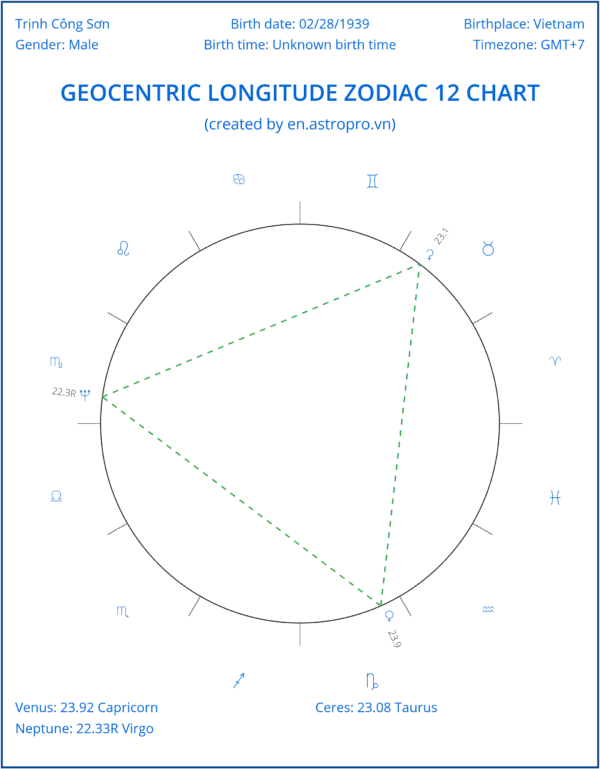
To interpret, we combine the keywords of these three planets, for example:
Trịnh Công Sơn loves art, has artistic abilities (Venus + Neptune), prioritizes it (Ceres), and can earn a significant amount of money from it (Venus + Neptune + Ceres).
For unfavorable geometries, we will also combine the keywords of the constituent planets but will have to negate their positive qualities.
For example, singer Lady Gaga was born with a T-Square planetary geometry consisting of:
Sun + Sappho = Neptune + Pallas.
The T-Square above is formed by 5 negative geometries, including 3 Square Aspects and 2 Opposition Aspects, but with only 1 positive Conjunction aspect.

Therefore, this is considered an unfavorable geometry. To interpret, we combine the keywords of the 4 constituent planets but negate them, for example:
Lady Gaga is an individual (Sun) with chronic anxieties in life (Sappho), especially when it comes to arranging, organizing, and planning (Pallas), and this makes her feel internally unsettled (Neptune).
Exploring the Geocentric & Heliocentric Longitude Zodiac 7 Dimension
Next, let’s move on to Geocentric Longitude Zodiac 7 & Heliocentric Longitude Zodiac 7.
The Longitude Zodiac 7 divides the 360-degree circle into 7 parts of 51.43 degrees, and examines the aspect interactions of planets.
Specifically, there will be 3 types of aspects:
-
Septile, approximately 51.43 degrees
-
Bi-Septile, approximately 102.86 degrees
-
Tri-Septile, approximately 154.29 degrees
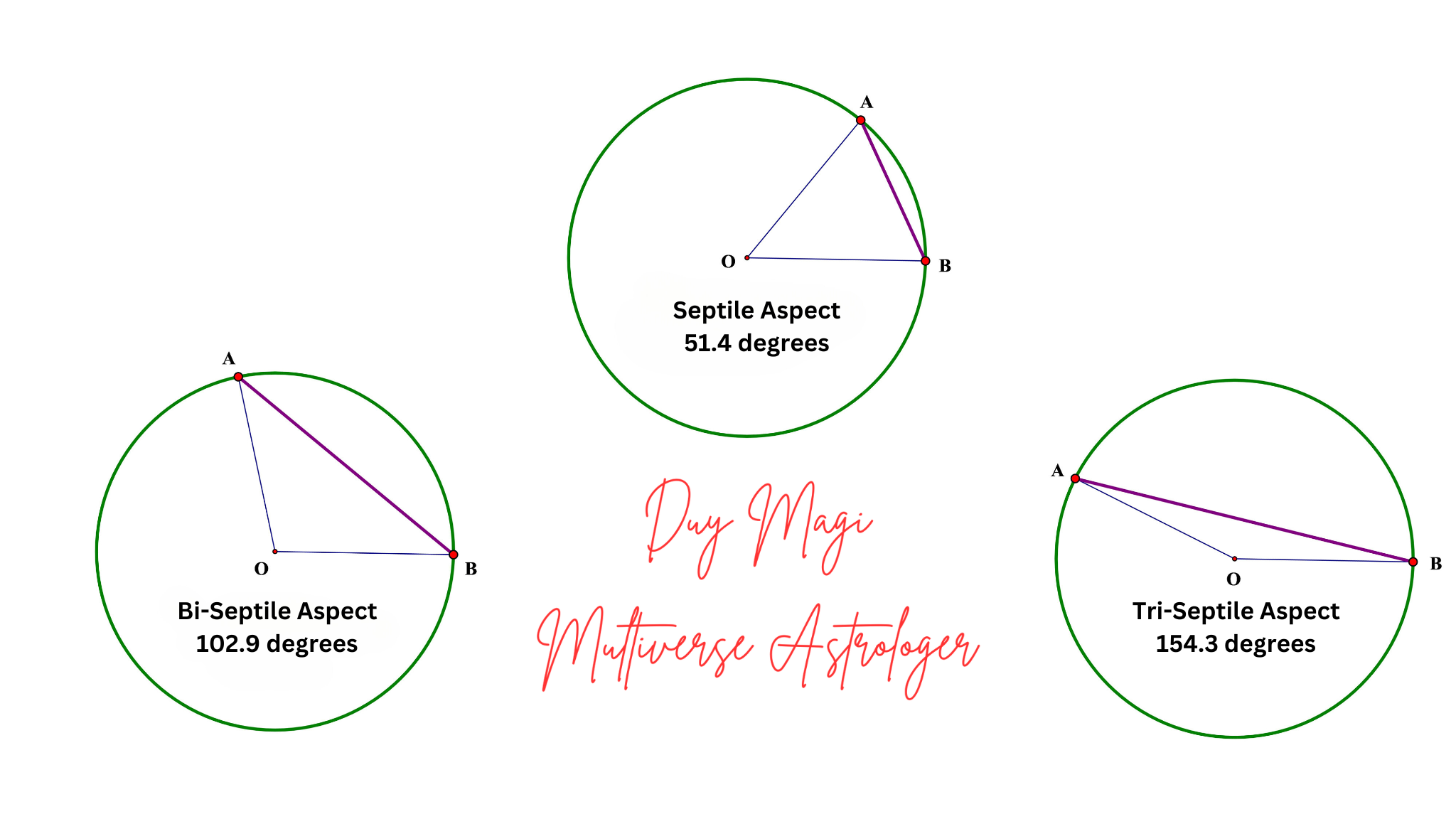
All aspects in the Zodiac 7 dimension are considered dual. Specifically, an aspect will be positive when both participating planets are positive.
Conversely, if one planet is negative, the aspect becomes unfavorable. Typical negative planets used in Multiverse Astrology are Saturn, Sappho, Xanthus.
The Aspect Orb for these aspects is 3 degrees for both Geocentric Longitude Zodiac 7 and Heliocentric Longitude Zodiac 7. However, in some cases, we may extend the Orb to 4 degrees. I will have a separate video explaining this issue.
To interpret these planetary geometry combinations, we will also apply the rule of counting the number of favorable and unfavorable aspects accordingly.
A combination will be considered positive when the number of positive aspects is equal to or greater than the number of negative aspects.
Conversely, when the number of negative aspects dominates, the combination will transform into a negative one.
Therefore, before interpreting the combination, you must count the number of favorable and unfavorable aspects.
For example, Donald Trump was born with a Yod geometry in the Heliocentric Longitude Zodiac 7, consisting of:
Earth + Odin + Juno.
This combination is composed of all 3 positive aspects, making it a positive combination.

To interpret, we combine the keywords of the three planets, for example:
Donald Trump is an individual (Earth) with a rich imagination (Juno). And this helps him assert his position easily (Odin).
Exploring the Geocentric Declination & Heliocentric Latitude Dimension
Now, let’s move on to the Geocentric Declination and Heliocentric Latitude dimension.
The Geocentric Declination and Heliocentric Latitude dimension determine the interaction between planets as they move vertically. In the Heliocentric Latitude dimension, the Earth will be displayed at the center of the chart, representing all of humanity.
There are only 2 types of aspects in the Geocentric Declination and Heliocentric Latitude dimension:
-
Parallel: Occurs when two planets are on the same half (same Northern Hemisphere or same Southern Hemisphere).
-
Contra Parallel in Geocentric Declination & Contra Latitude in Heliocentric Latitude: Occurs when two planets are on different hemispheres, one on the Northern Hemisphere and one on the Southern Hemisphere.
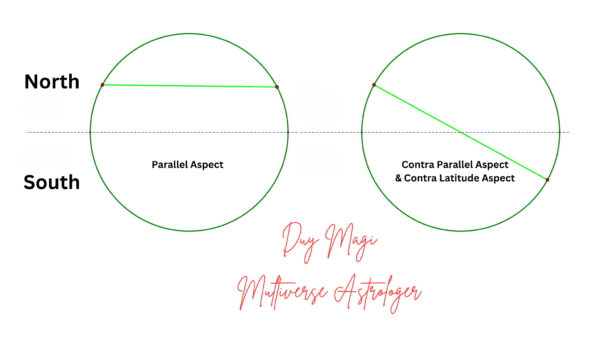
Specifically, the Parallel aspect is considered a positive aspect, equivalent to the Conjunct or Trine aspect.
Conversely, the Contra Parallel aspect and Contra Latitude aspect are considered to have dual nature. It can be positive if both participating planets are positive, but it becomes negative if at least one negative planet, such as Saturn, Sappho, or Xanthus, is involved.
The Aspect Orb used in the Geocentric Declination is 1.2 degrees. The Aspect Orb used in the Heliocentric Latitude is 0.3 degrees.
However, as with the previous four dimensions, in some cases, we are allowed to extend the Orb in these 2 dimensions. I will have a separate video explaining this issue.
To interpret combinations of planets in these 2 dimensions, we will also apply the rule of counting the number of favorable and unfavorable aspects accordingly.
A combination will be considered positive when the number of positive aspects is equal to or greater than the number of negative aspects.
Conversely, when the number of negative aspects dominates, the combination will transform into a negative one.
Therefore, before interpreting the combination, you must count the number of favorable and unfavorable aspects.
For example, Madonna was born with a cluster of three parallel planets in Geocentric Declination dimension:
Sun + Mars + Ceres
Since all three aspects are positive, this combination is considered positive.
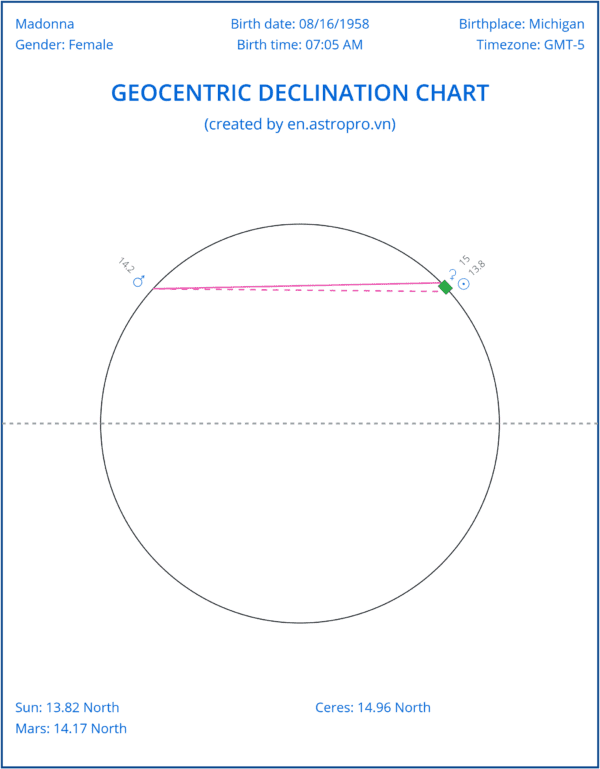
To interpret, we combine the keywords of the three planets, for example:
Madonna is an individual (Sun) who is assertive, active, and unafraid of physical activities (Mars), and knows how to prioritize self-desired pursuits (Ceres).
The Simple Beauty and Logic of Multiverse Astrology
To read a birth chart in Multiverse Astrology is generally quite simple and logical.
You only need to analyze each geometry in all 6 dimensions one by one. The analysis revolves around counting the number of favorable and unfavorable aspects in each combination, and then combining the keywords.
However, it is recommended to start with geometries containing Sun or Earth in each dimension. And the reason is that Sun and Earth in Multiverse Astrology are the soul of the birth chart.
Therefore, combinations containing Sun and Earth are generally stronger than other geometries and must be the starting point when you want to read a birth chart in Multiverse Astrology.
After analyzing all the planetary geometries, it is essential to spend some time synthesizing the results.
And the energies that repeat more frequently are stronger and more pronounced in the native.
However, it is important to note the differences between the Geocentric universe and the Heliocentric universe.
Specifically, the Geocentric universe focuses on the inner world of an individual, while the Heliocentric universe discusses how the person interacts with the external world and how others perceive them.
Therefore, depending on which aspect of their life you want to explore, you should focus on analyzing the corresponding dimensions.
Multiverse Astrology Study Group
And that concludes today’s video. I will have more videos in the future teaching you in more detail about the skills of how to read a birth chart using the Multiverse Astrology method.
Follow my channel and join the Multiverse Astrology Facebook Group if you want to understand the language of the universe.
If you have questions, feel free to comment. I’ll respond when I have time.
If you want to schedule an astrology consultation, inbox me or click the link in the description below.
If you want to get your 6 birth charts for free, please visit Free Online Birth Chart Drawing Tool at: https://en.astropro.vn/
Now, goodbye.
Hourly Astrology Consulting Service
Auspicious Date Selection Service
Learn Multiverse Astrology






